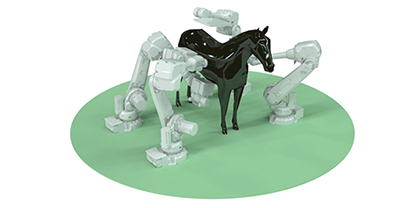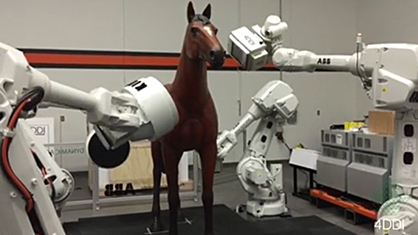First Vet Hospital to Pioneer Use of Revolutionary Robotics-Controlled Imaging System for Standing and Moving Horse
By: Louisa Shepard
Penn Vet’s New Bolton Center, in collaboration with Four Dimensional Digital Imaging (“4DDI”), will pioneer a first-ever, robotics-controlled imaging system for use in the standing and moving horse. Penn Vet is the first veterinary hospital in the world to own the revolutionary technology.
The four-robot system can perform multiple modalities, including computed tomography (CT), and will be used in conjunction with a high-speed treadmill. The EQUIMAGINE™ imaging system will be capable of capturing the equine anatomy in a way never before possible, while the horse is awake, load-bearing, as well as moving on a treadmill.
“This will revolutionize equine imaging,” said Dr. Barbara Dallap Schaer, Medical Director of New Bolton Center, the large-animal hospital of the University of Pennsylvania School of Veterinary Medicine.
Existing CT systems require the horse to be anesthetized, and are limited to the parts of the animal that fit into the cylindrical machines. The EQUIMAGINE™ system’s robotics-driven design provides an unlimited range of motion and unencumbered access to the horse’s entire anatomy. The quality and resolution of the real-time images created with the system far exceeds existing technology.
“The open structure of the scanner will allow us to capture high-quality CT images of the standing horse that we have had difficulty imaging before,” Dallap Schaer said. “We will be working to develop protocols to diagnose problems in the lower neck, back, pelvis, and upper part of the legs.”
The system will be important not only for clinical use in the hospital, but also for research and teaching. The equipment will be installed in New Bolton Center’s high-speed treadmill building in December. This acquisition was funded in part by a generous gift from the estate of Mimi Thorington. Additional gifts will be sought to integrate the new technology into the clinical and research programs at New Bolton Center.
“Partnering with a world-class institution like Penn Vet is a priority for us as we transition from research to commercial application,” said Michael Silver, Chief Operating Officer of 4DDI, based in New York City.
Dr. Dean Richardson, Chief of Surgery at New Bolton Center, will provide clinical orthopedic expertise for the further refinement of the new system. Richardson has vast experience using imaging for treating horses with serious fractures.
“We routinely perform CT-assisted surgery with a much less versatile unit. Adding the ability to conduct CT scans on standing horses will improve the accuracy of both diagnosis and treatment,” Richardson said.
The new four-dimensional imaging is much more detailed, Richardson said, and can help to identify not only a fracture, but also its specific characteristics: location, depth, and breadth. He anticipates using the new technology to help prevent injuries, especially in racehorses.
“We believe that the technology will allow early identification of horses with incomplete “occult” fractures in areas that can proceed to catastrophic failure,” Richardson said. “We also are interested in working with other researchers around the world examining the relationship of the three-dimensional structure of a horse’s bone and its risk of fracture.”
One of the reasons 4DDI chose New Bolton Center to install its inaugural four-robot system is because of the skill and experience of the clinicians and researchers, Silver said. “Everyone there is absolutely incredible,” he said. “We are looking at this as a partnership. There is a lot of trust involved.”
A dedicated specialist from 4DDI will work with New Bolton Center clinicians during the first year to develop the capabilities of the system. In addition, radiologist Dr. Chris Ryan is joining New Bolton Center’s staff as part of the project.
Dr. JoAnn Slack, Associate Professor of Cardiology and Ultrasound in New Bolton Center’s Sports Medicine Section, will manage the clinical diagnostic use of the system.
“In sport horses, subtle problems of the neck, back, and pelvis affect performance, and are areas of substantial concern for riders and trainers,” Slack said. “Having the ability to image these areas more effectively will greatly improve our understanding and enable us to provide a more accurate diagnosis.”
The fluoroscopy and CT capabilities of the system have tremendous potential for advancing cardiovascular imaging and treatment, Slack added.
4DDI is expecting to gather first-ever images and important analysis on the system’s ability to image a moving horse. The four-robot system is capable of producing several distinctive modalities,unencumbered by an enclosed gantry or a C-arm, making it possible to scan any part of the horse. The modalities include: CT, fluoroscopy, tomosynthesis, digital radiography, and a high-speed radiographic camera that will be able to operate at up to 16,000 frames per second.
The ability to assess the musculoskeletal system, not only in a weight- bearing position, but also while in motion, allows for new areas of assessment in the performance animal never before encountered, Silver said.
“The best analogy to illustrate the difference between EQUIMAGINE™ and current imaging technology is to envision the deep, inaccessible parts of the ocean that we know are there but have not before explored,” he said. “Our system will open up these uncharted regions.”
For more information visit www.vet.upenn.edu/equimagine.
About Penn Vet
Penn Vet is a global leader in veterinary education, research, and clinical care. Founded in 1884, Penn Vet is the only veterinary school developed in association with a medical school. The school is a proud member of the One Health Initiative, linking human, animal, and environmental health.
Penn Vet serves a diverse population of animals at its two campuses, which include extensive diagnostic and research laboratories. Ryan Hospital in Philadelphia provides care for dogs, cats, and other domestic/companion animals, handling more than 30,000 patient visits a year. New Bolton Center, Penn Vet’s large-animal hospital on nearly 700 acres in rural Kennett Square, PA, cares for horses and livestock/farm animals. The hospital handles more than 4,000 patient visits a year, while the Field Service treats nearly 37,000 patients at local farms. In addition, New Bolton Center’s campus includes a swine center, working dairy, and poultry unit that provide valuable research for the agriculture industry.
For more information, visit www.vet.upenn.edu.
About 4DDI
4DDI’s technology was developed over the past decade as a solution to address many of the shortcomings and limitations of conventional imaging technology. Originally intended for human application, 4DDI’s robotic-controlled imaging system has been adopted for animal and industrial applications. Its innovative employment of industrial robots to manipulate the imaging apparatus, coupled with 4DDI’s proprietary software, provides an unlimited scanning geometry capable of producing images of an unprecedented quality and resolution.
For more information, visit www.equine4ddi.com.












